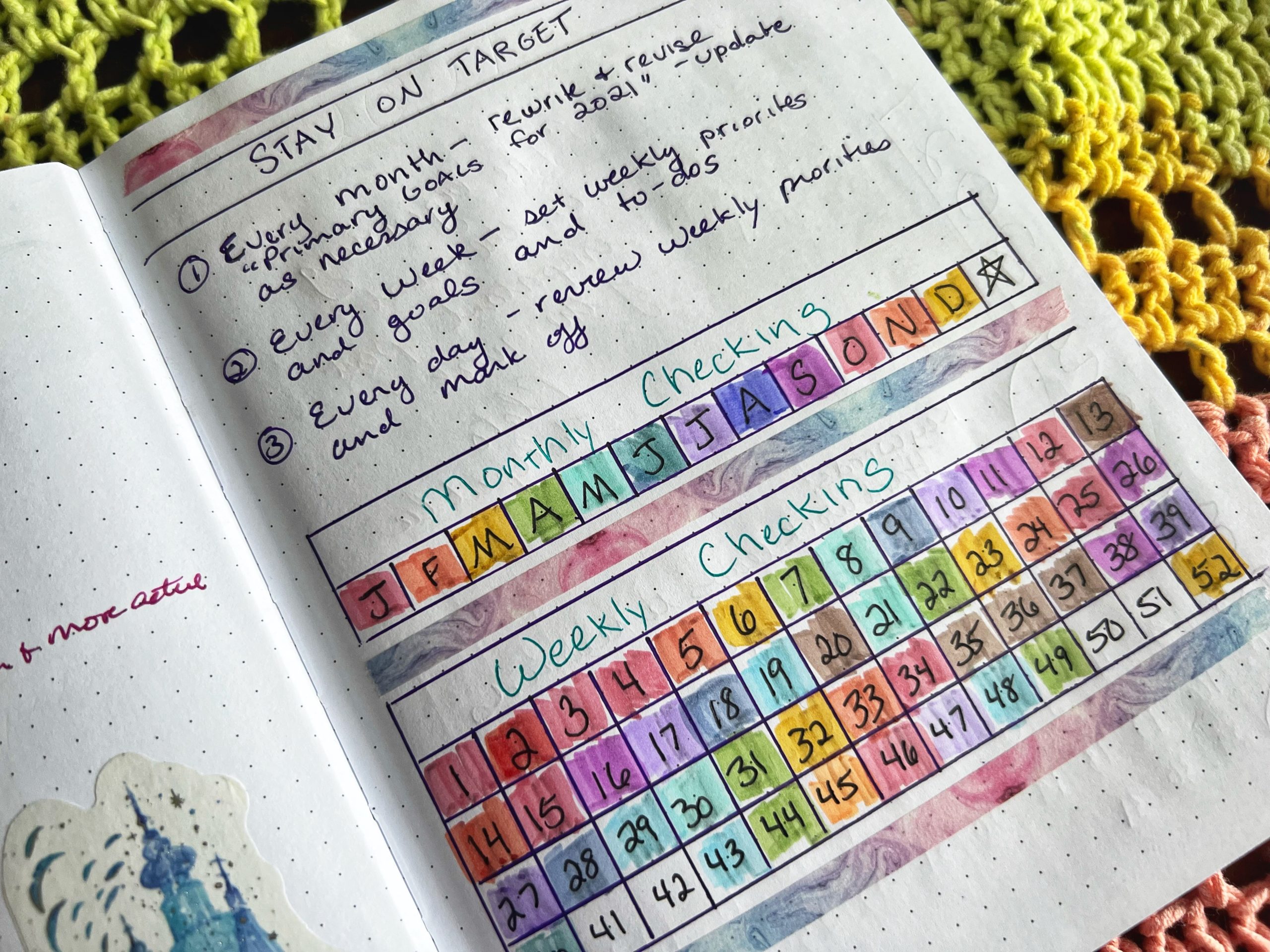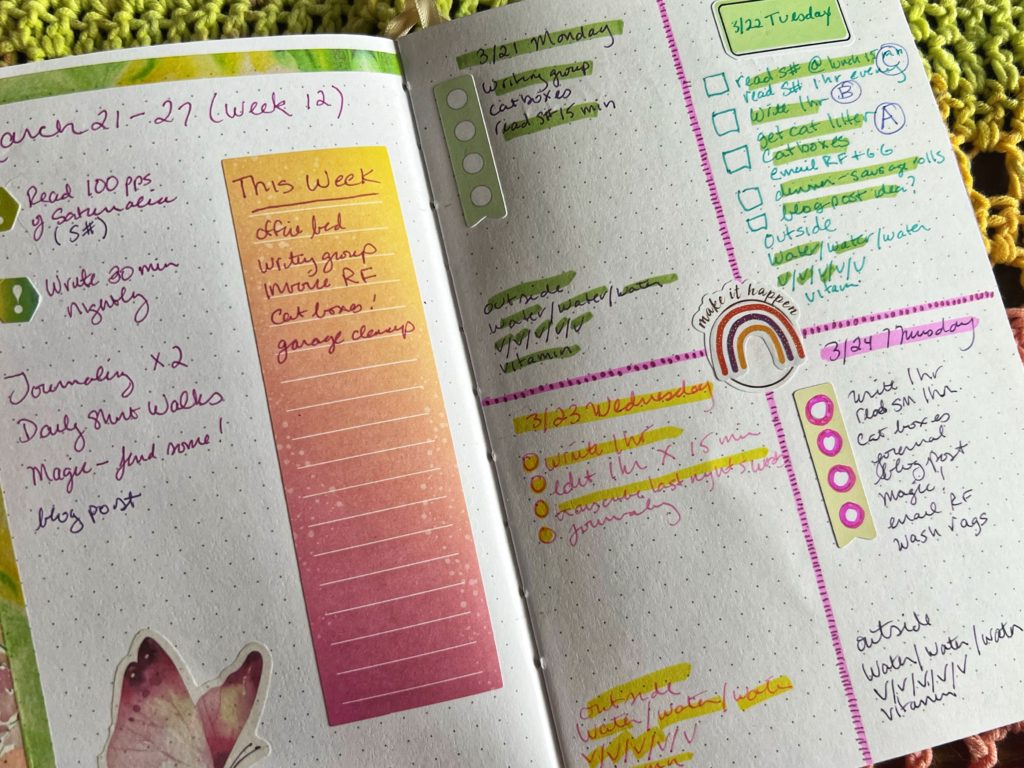
It’s January 1st, and that means that I am in the midst of prepping my planner for the coming year. With a daily blog challenge officially launched, on top of myriad other goals and priorities across the facets of my life, I know I’m going to have to stay on top of things if I want to be successful at any of it.
For the last few years, I have used a dot grid journal for my personal planner. I love the flexibility that a blank journal gives me. I am not always the most consistent when it comes to planning, and I like not having empty chunks of dated calendar pages when I don’t pick it up for a few days or weeks or even months. Plus, it gives me lots of space to keep extra notes or lists when need arises. More and more, I like to use my planner as a sort of commonplace book, too, collecting random bits of information and inspiration. I also like to be able to decorate the pages, mostly just with colored pens, stickers and washi tape, but sometimes paint, so I like that I can get books with nice heavy paper. The decorations fill my journal with color that makes me more likely to want to engage with it regularly.
As for the planning system I use, I’d say it’s bullet-journal inspired, but it doesn’t adhere to some of the core principles at the foundation of bullet journaling — I don’t use yearly or monthly calendars, for example, and this year I’m giving up the index because I never keep it up to date. I don’t even use bullets. 1 My daily task lists are pretty sparse, as most of my non-day-job tasks are fairly routine. I use habit trackers, though the truth is they haven’t been super-effective at helping me shape new habits. Today, I’m thinking about how I can refocus them so that they are more useful for me personally.
My favorite part of my planners are my weekly, monthly and annual pages. These aren’t calendars, but check-in pages that align with the overall philosophy of all my planning efforts: Stay on Target.
At the start of 2021, as I was searching for the “word of the year” that would inspire me for the next 12 months, I realized that I didn’t need a word, but a strategy that would help me stay focused on my diverse ambitions. That’s when I devised the “Stay on Target” formula, which doesn’t depend on any particular planning method, but instead is a reminder to keep checking in on my goals and priorities to make sure I am making progress towards them. Caught up in the drudge of day-to-day life, it can be easy to lose site of what I’m really trying achieve. Stay on Target is a way to reclaim focus throughout the year.

The first step of Stay on Target is to take a moment (presumably at the start of the year, but really whenever ) to write down your priorities and goals — mine generally fall into the large categories of writing, editing, health and finance.
After that, there are three key steps:
- Every month, review and revise those primary priorities and goals, updating as necessary.
- Every week, set weekly priorities, goals, and to-dos.
- Every day, review weekly priorities, make to-do list and mark off.
See, it’s pretty simple, and it is not dependent on any particular kind of planner. It’s a mindset, not an organization system, the key to which is revisiting your planner regularly not just as a task minder, but as a mind-shaper.
At the start of each month, I create a two-page spread where I write down priorities for the month, the areas I want to focus on the most. These are generally pretty high-level. A third page is habit trackers, for things I want to do daily or nearly daily. These might change from month to month, except for the “daily checkin” tracker.
Each week, I do a weekly page, usually Sunday night or Monday morning, but I’ve ended up doing them midweek on occasion. Weekly pages are more concrete with the things I need to do: make a doctor’s appointment, finish writings chapter three, start taxes, etc. Sometimes I’ll mark what day of the week I want to do it on, but not always. Sometimes weekly pages also include general reminders of things I want to do more frequently: drink water daily, morning walks, write nightly.
Every day, I make a to-do list. In 2021, my to-do lists were separate sheets — I used a sticky memo pad and stuck the each day’s list to the top of the planner. It worked fine, but I got eco-conscious of all that throwaway paper. So in 2022, I decided to keep daily lists within the planner itself. But I also experimented with not having daily lists at all, and just revisiting the weekly page every day. I’m honestly not sure yet what I’ll try this year. But that’s the great thing about this system — I can adjust as I go.
And just like I can change up the planner’s layout, I can revise my goals and priorities as the year moves along. One thing I’ve learned over the past couple of years is that the world will change unexpectedly and we need to be prepared for change. But just like an X-Wing on the tail of a TIE Fighter, I can plan to Stay on Target, no matter what happens.
